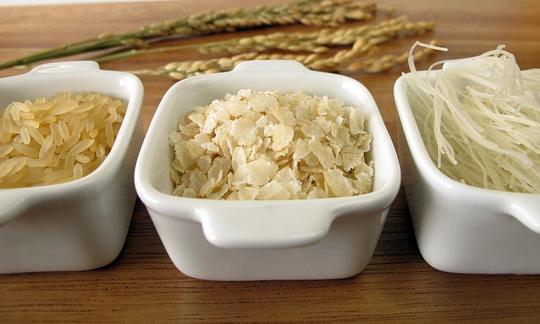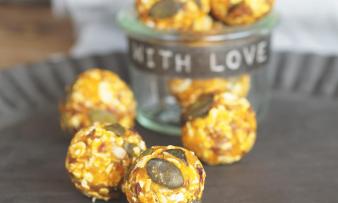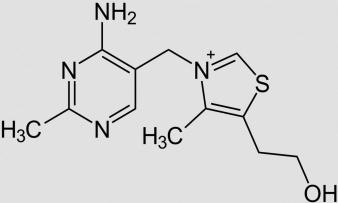Table of contents
What are rice flakes? The basis for the production of rice flakes are polished rice grains (white rice) or whole grain rice grains, which are rolled into rice flakes. If you want to ensure the raw quality of rice flakes, it is best to crush the rice flakes yourself. Below we describe the raw rice flake based on the medium-grain, brown whole grain rice grain .
Use in the kitchen
Rice flakes are considered a gluten-free alternative to other cereal flakes and are used as cereal in muesli and cereal purees such as porridge. For porridge, you can use a mixture of rice flakes and oat flakes and prepare the puree with plant-based drinks (soy milk, oat milk, almond milk, etc.) instead of milk. Rice flakes ( organic ) are also suitable for making rice pudding and other desserts such as rice flake pudding. When baking sweet desserts such as muffins, cakes or fruit bread, you can replace some of the flour with rice flakes to give the dough a lighter consistency.
If used creatively, rice flakes can be used to make hearty main dishes such as vegan nuggets or patties. Unlike rice patties, which often contain buckwheat or millet, patties made from rice flakes tend to contain breadcrumbs or black beans to give them consistency or as a binding substance. Other rice recipes that can be made using rice flakes include various versions of risotto. The advantage of alternative recipes with rice flakes is the time required: rice flakes absorb liquids very quickly and are therefore cooked more quickly than conventional rice. This also applies to desserts such as rice pudding and porridge. The recipes are less successful if you prefer a coarse-grained consistency. In addition to the sweet variation of porridge, you can also cook salty rice flake variants as a healthy lunch menu, e.g. an Indian poha.
Another common application is the production of baby food based on rice flakes. The rice flakes used here are usually made from wholegrain rice flour. When buying such baby food, it is important to note that rice may have an increased arsenic content (see "Danger - Intolerances - Side Effects").
Spices that are often used in sweet recipes with rice flakes include cinnamon or vanilla (for dishes such as rice pudding, porridge, cakes or fruit bread). Sweet dishes are often supplemented with amaranth, nuts, millet, raisins, etc. Indian cuisine often uses spices and additives such as cardamom, cumin, curry, nuts and raisins.
your own
To make rice flakes, you only need a flake press and medium-grain, brown wholegrain rice. You fill the raw rice into the flake press and turn it through it. This way you can make rice flakes yourself in the desired quantity quickly and easily.
Rice flakes can also be made from other types of rice, but it is recommended to always use the whole grain, as the proportion of vitamins, trace elements, minerals and fiber in whole grain rice is higher.
Vegan recipe for porridge based on rice flakes
Ingredients (for 3 portions): 120 g rice flakes (organic, e.g. from medium-grain, brown whole grain rice ), 350 ml almond milk , 1 tbsp rice syrup (alternatively: honey), 1 tsp cinnamon , 150 g seasonal fruit, 50 g topping (e.g. nuts, amaranth , millet ).
Preparation: Put the rice flakes, almond milk, cinnamon and rice syrup in a pot and let the rice flakes soak for about 30 minutes. Then simmer the mixture over medium heat, stirring occasionally, for about 12-15 minutes. Once the mixture has cooled, mix it with the chopped fruit. Now you can serve the rice flakes in bowls, add a topping of your choice and enjoy.
Vegan recipe for bread made from apple and rice flakes
Ingredients: 3 finely diced sour apples , 1-2 overripe mashed bananas , 2-3 mashed dates , 200 g rice flakes (organic), 100 g almond flour (alternatively buckwheat flour), 1 teaspoon baking powder , 1 teaspoon baking soda , 2 tablespoons linseed flour + 4 tablespoons water, 2-3 tablespoons rapeseed oil , 1 tablespoon freshly squeezed lemon juice and 1/2 teaspoon vanilla (ground).
Preparation: Preheat the oven to 180 degrees and let the linseed flour swell with water. Then mix the rice flakes and almond flour with the baking powder and baking soda in a bowl. In another bowl, mix the bananas and pureed dates with the diced apples, the swollen linseed, the lemon juice and rapeseed oil. Now mix the wet ingredients with the dry ingredients and process them into a smooth dough. Pour the dough into a loaf pan lined with baking paper and smooth it out. Optionally, you can season the bread with a little cinnamon powder. Place the baking pan on the middle shelf in the oven and bake the bread for approx. 50 minutes. Allow to cool well and store in the refrigerator.
Vegan recipe for Indian Poha
Ingredients (for 1 portion): 200 g rice flakes (organic), 1/2 medium onion , 1/4 teaspoon turmeric , 1 teaspoon cumin , 1 sprig of curry leaves , 2 green chillies , 2 tablespoons sesame oil (or rapeseed oil), 2 sprigs of coriander , 1 lime , salt .
Preparation: To prepare, put the rice flakes in a bowl of cold water and mix them with your hand until they have absorbed some of the water. The rice flakes should not be soaked for too long, otherwise a paste will form. Then chop the onion and chili peppers and put them to one side.
Now heat the oil and add the cumin and turmeric. Add the chilli peppers and curry leaves and fry everything gently for about half a minute. Then add the chopped onions, reduce the heat and cover the pan with a lid. The onions should be sautéed but not brown.
Gently fold in the rice flakes until the mixture evenly takes on the color of the turmeric. Season the poha with salt to taste and let it steam with the lid on over low heat for 5 minutes. Then remove the lid and let the poha cook with the lid open for another minute. You can now serve the poha in a bowl and garnish with chopped coriander and lime wedges.
Vegan recipes with rice flakes can be found under the note: " Recipes that have the most of this ingredient ".
| Not only vegans or vegetarians should read this: Vegans often eat unhealthily. Avoidable nutritional mistakes |
Purchasing - Storage
Rice flakes can occasionally be found on offer in supermarkets or wholesalers such as Coop , Migros , Denner , Volg , Spar , Aldi , Lidl , Rewe , Edeka , Hofer etc. Rice flakes are also available in various variations online. However, they are usually not made from whole grains, which is due to the low fiber content of the products. Ideally, you should therefore buy rice flakes based on whole grain rice in selected health food stores, organic shops or organic supermarkets ( Denn's Biomarkt , Alnatura ) or in Indian specialty shops. The same applies to rice if you make the flakes yourself.
When buying rice as well as processed products such as rice flakes, it is important to ensure that the products are of the highest organic quality.
In commercially available rice flakes, the rice grains are usually steamed before rolling. This means that the crushed rice flakes retain their shape better. After steaming and rolling, the rice flakes are gently dried at warm air temperatures. To guarantee the raw food quality of the rice flakes, prepare the flakes yourself.
The availability of rice flakes varies depending on the size of the store, catchment area, etc. If you are interested, click on our recorded food prices for the DA-CH countries (above under the ingredient image). There you will find current prices from various supermarkets and their price development.
Ingredients - Nutritional Values - Calories
The ingredients of rice vary depending on the variety, environmental conditions and cultivation techniques. However, all varieties have one thing in common: they consist mainly of carbohydrates.
On average, 100 g of rice flakes made from wholegrain rice have the following ingredients: The nutritional value is 386 kcal, the fat content is 2.8 g/100g, the fiber content is 3.9 g/100g and the protein content is 7.4 g/100g. Rice flakes are gluten-free and therefore digestible for people with celiac disease. The fat content of wholegrain rice flakes is 2.8 g/100g, which is significantly lower than the fat content of oat flakes, which have a content of 6.5 g/100g. 9 The low fat content (compared to other grain products) contributes to the good digestibility of rice flakes and makes them a lower-calorie option.
Since whole grain rice is not peeled, rice flakes made from medium-grain, brown whole grain rice contain more vitamins, minerals and trace elements (especially magnesium , calcium , iron , zinc , vitamin B 1 and vitamin B 3 ) than flakes made from white rice. This is thanks to the germs and silver skins that remain in or on the whole rice grain. Additional thiamine (vitamin B 1 ) is often added to commercially available rice flakes within the legally prescribed limits. Thiamine is a water-soluble vitamin from the B vitamin series that fulfils many functions in energy metabolism and the nervous system. A thiamine deficiency can cause cardiovascular disorders and impair the nervous or immune system (such as in Wernicke-Korsakoff syndrome). 1
The trace element manganese contains 4.9 mg/100g. Oat flakes ,pumpkin seeds and wheat have similar values, while wheat germ and wheat bran have a very high manganese content in comparison. Manganese is very important for the formation of cartilage tissue, among other things.
The complete ingredients of rice flakes, the coverage of the daily requirement and comparison values with other ingredients can be found in our nutrient tables. In the article Nutrients explained you will get a detailed insight into the topic. CLICK FOR under the ingredient picture.
Health effects
How healthy are rice flakes? Thanks to the (approximately two to three times) higher fiber content, rice flakes made from wholegrain rice keep you fuller for longer than rice flakes made from white rice. In addition, the risk of type 2 diabetes is reduced if you prefer to eat rice flakes made from wholegrain rice. In general, the consumption of white rice (compared to the same amount of brown wholegrain rice) produces a stronger blood sugar response, which can be measured by the glycemic index (GI). The average GI for white rice is 64 ± 7, for brown wholegrain rice 55 ± 5. An increased GI is associated with an increased risk of type 2 diabetes. 2
Rice also has a dehydrating effect: Due to the water-binding properties of the grain and the mineral content of potassium (especially in brown wholegrain rice), the body flushes water out after eating rice (flakes). 3 This property is enhanced by the low sodium content of rice. However, rice only retains its dehydrating effect if little (or no) salt is added to the dish. 4
Dangers - Intolerances - Side effects
Rice can accumulate arsenic if the groundwater used for irrigation is contaminated with arsenic to a high degree. 4 In general, arsenic can occur in two forms in food: in organic and inorganic form (arsenite and arsenate). This applies, for example, to foods such as rice, fish, seafood and algae. Organic arsenic compounds are considered relatively harmless, while inorganic compounds are classified as highly toxic and carcinogenic. Inorganic arsenic compounds are found both in the soil and in the groundwater used for irrigation. 5 Because rice needs a lot of water to cultivate, or is even grown in stagnant water, the rice plant accumulates ten times more arsenic than other types of grain. The extent of the contamination therefore depends primarily on the quality of the water. 4 Hulled rice generally contains less arsenic than unhulled rice; However, according to the BfR , if you have a diet that is not extremely rice-heavy, you don't have to worry that wholegrain rice could be harmful to your health. 6
The arsenic contamination of the varieties available on the world market varies from 20 to 900 micrograms of arsenic per kilogram (for comparison: the maximum value for drinking water in the EU is 10 micrograms per liter). 7,8 A scientific study from 2013 classifies rice as genotoxic if the arsenic contamination exceeds 200 μg/kg ( for our study population, 200 μg/kg total arsenic was equivalent to approximately 180 μg/kg inorganic arsenic in rice and to a mean daily intake of inorganic arsenic of 2.0 μg/kg-bw/day ), which is slightly below the WHO tolerance level. 10
Women who eat rice contaminated with arsenic during pregnancy could endanger the development of their unborn child. 4 Baby and children's food such as rice cakes or purees based on rice, rice flakes or rice flour are also contaminated. The Federal Institute for Risk Assessment ( BfR ) therefore recommends that infants and small children should not be fed exclusively with rice-based food. 6 The same specialist agency also warns against packaging instructions that recommend a lot of rice flakes for preparing infant formula and puree. 11
Rice flakes are a gluten-free alternative to cereal flakes for people with celiac disease. Look for the gluten-free symbol, which only licensed products are allowed to carry. If there is no symbol, caution is advised, as the machines may have been used to produce other cereal flakes and therefore traces of other types of grain are possible.
Ecological footprint - animal welfare
Rice flakes are made from rice, one of the world's most important crops. After sugar cane and corn, it is the most produced agricultural product 4 and is a staple food for almost half the world's population 12. Rice is grown in different ways: there is dry rice cultivation and traditional wet rice cultivation (see also: jasmine rice ). Wet rice cultivation produces higher harvest yields and prevents the growth of weeds, but has a worse ecological footprint than dry rice cultivation. This is because the rice fields are regularly flooded, which requires an immense amount of water. In addition, bacteria settle in the water and decompose the organic material in the soil. This process produces methane, a gas that is around 25 times more harmful to the climate than carbon dioxide (CO 2 ). Both greenhouse gases are produced on a large scale in rice production. The ecological footprint of rice (measured in CO 2 equivalent/kg of food) is 5 times higher than that of oat flakes.13 The additional production steps for the manufacture and transport of rice flakes further worsen the footprint.
Conventional rice cultivation involves the extensive use of herbicides, fungicides and insecticides. These are also found in food, whether raw or cooked. 14 This is not only dangerous for humans (they are suspected of causing liver and kidney damage, for example 15 ), it also has a negative impact on other living creatures. The use of insecticides harms waterfowl, which are increasingly using rice fields due to the decline of their natural habitat and are absorbing the toxic substances there. The increased large-scale use of pesticides in rice cultivation in recent years has already led to a loss of biodiversity and pollution of water sources. 16 Organic farming, which avoids the use of synthetic pesticides, is more environmentally friendly.
Further information
Rice is the name given to the grains of the plant species Oryza sativa and Oryza glaberrima . The main rice-growing regions are on the Asian continent and are located in China, India and other parts of Southeast Asia. More than 90% of the yield comes from this region. 4 A major European growing area is in northern Italy, in the Po Valley. The plant species Oryza sativa is grown in many countries around the world, while the cultivation of the plant species Oryza glaberrima (also called "African rice") is traditionally rooted in West Africa.
After harvesting, the so-called raw rice or paddy rice is produced by threshing and reducing the water content (to 14 to 16%). The rice is then freed from the inedible husks or lemmas in a rice mill. Paddy rice with husks poses a risk of suffocation, especially for small children. After dehusking, the unhusked rice remains, which consists of endosperm, germ and silver skin. For this reason, unhusked and unpolished natural rice (or "integral rice") is also known as brown rice, whole grain rice, natural grain rice or cargo rice. The name cargo rice can be traced back to the fact that the rice is usually exported in the unhusked and unpolished form. The unhusked rice has lost 20% of its original weight.
Alternative names
Alternative names for rice flakes are flakes made from rice, rice flakes, rice flakes or squashed rice.
In English it is known as rice flakes, flattened rice, beaten rice, poha, pohe or aval (avil).
Other applications
Rice flakes are also a component of animal feed and serve as a nutritional supplement for dogs and rodents, for example.









Comments